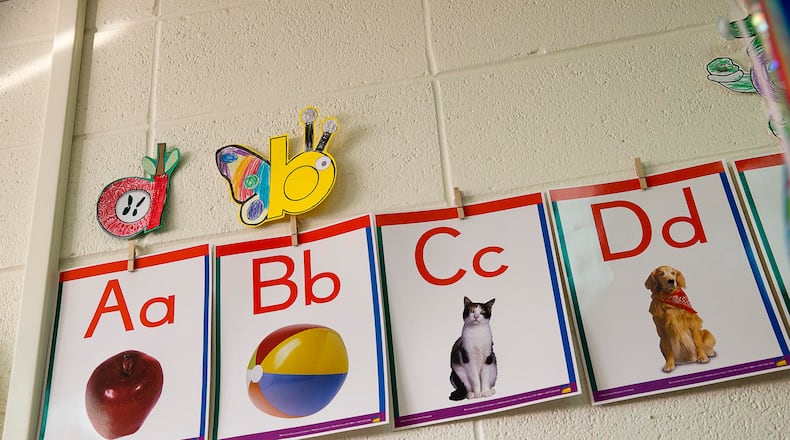Fewer metro Atlanta schools appear on the annual "turnaround eligible" schools list, Georgia's designation of the worst-performing schools.
The statewide number held steady at just over a hundred schools. More metro Atlanta schools fell off the list than were added, though the area still fills out about a quarter of the list, which numbers 105 this year, up from 104 in preceding years.
To make the Governor's Office of Student Achievement's 2019 list, schools had to consistently perform at the bottom on the Georgia Department of Education's school report card, known as the College and Career Ready Performance Index.
The number has held steady because it is based on a fixed percentage of all schools in the state. The criteria for inclusion is a report card score in the bottom 5% for three years in a row.
Among the 35 newly listed schools were eight in metro Atlanta’s core jurisdictions, with two in Atlanta, three in Clayton County, two in DeKalb County and one in Fulton County, according to an analysis by The Atlanta Journal-Constitution. Three of those districts were able to remove twice that many schools, though: three Atlanta schools came off the list, as did six in DeKalb (one through closure) and seven in Fulton. Statewide, 34 schools came off.
With the new additions, Atlanta Public Schools now has a dozen on the refreshed list, Clayton has three (the district had none last year), DeKalb has 10 and Fulton has three.
Schools remaining, or newly named, to the list are eligible for intervention by the state’s Chief Turnaround Office, a legacy of former Gov. Nathan Deal. The office was created at his urging by lawmakers in 2017.
In addition to creating that office, The First Priority Act amended the listing criteria. Under the old rules, schools made what was then known as the "chronically failing" list by scoring less than 60 points for three years in a row on the 100-point report card. That list grew to 153 schools before the law changed.
So far, Chief Turnaround Officer Eric Thomas has not intervened in any metro Atlanta schools, focusing his efforts instead in rural Georgia, where cash-strapped school districts have welcomed his assistance.
Thomas has cast his job as a collaborative one geared mainly toward helping schools cope with poverty. Some districts, especially in metro Atlanta, have remained wary of involvement because lawmakers established penalties for failure to improve under the CTO's watch. Teachers can get replaced, principals can lose their jobs and school boards can lose control.
Some question the value of the list, especially in a state with multiple lists. Last month, the Georgia DOE released its own worst-performing list, called Comprehensive Support and Improvement. Those schools get help from that agency. There is some overlap between the lists, but they are not identical.
That can bewilder parents and communities, said Dana Rickman, vice president of the Georgia Partnership for Excellence in Education. “All these competing lists are very confusing,” she said, adding that the criteria are a bit arbitrary. “What if you’re in the 5.1 percent? Are you OK? We don’t have to worry about you?”
Also consider that both Gov. Brian Kemp and state school Superintendent Richard Woods have criticized the measure that informs these lists. Last month, when the new CCRPI results showed average scores falling in Georgia, Kemp called for "refinements" to the index.
The turnaround list does draw attention though. Atlanta Superintendent Meria Carstarphen said through a spokesman that the district has been sending math and reading specialists and other help to listed schools. DeKalb and Fulton counties also said their listed schools got attention from district leaders.
“Our board has had a focus on getting these schools off the list,” said Cliff Jones, the chief academic officer for Fulton County Schools. Fulton generally lets its schools run independently, but the turnaround eligible schools lost some of their freedom. The district analyzed student test results to find areas where students were stumbling, then imposed 90-day plans that included tailored curriculum. In one school with high turnover, new teacher training was mandated.
In addition to the seven Fulton schools that came off the list, the two that remained had rising scores. Jones said he has been visiting the school that was just added.
“We’re not done,” he said. “The board is very focused on making sure we don’t have any failing schools.”
The 2019 “turnaround eligible” schools list in metro Atlanta
Eight added:
- Cascade and Slater elementary schools — Atlanta
- Huie and Northcutt elementary schools and Jonesboro middle school — Clayton County
- Flat Rock and McNair elementary schools — DeKalb County
- Bethune elementary school — Fulton County
Sixteen removed:
- Finch and Gideons elementary schools and Hollis elementary-middle school — Atlanta
- Miller, Panola Way, Peachcrest and Stone Mountain elementary schools, Lithonia middle school and Destiny high school (it closed) — DeKalb County
- Hilliard, Feldwood, Nolan and Parklane elementary schools and West, McNair and Woodland middle schools — Fulton County
Twenty carried over from last year:
- Boyd, Fain, Scott, Thomasville Heights and Woodson Park elementary schools; Harper-Archer, Price and Young middle schools; and Carver and Douglass high schools — Atlanta
- Fairington, Flat Shoals, Murphy Candler, Redan, Snapfinger, Stoneview and Toney elementary schools and McNair middle school — DeKalb County
- College Park and Lewis elementary schools — Fulton County
About the Author
Keep Reading
The Latest
Featured



